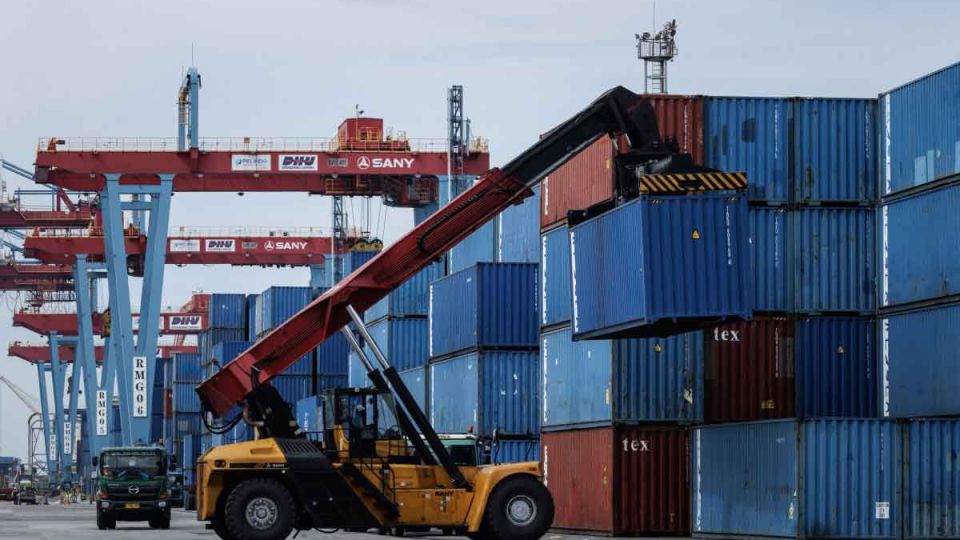
The country has recorded its lowest trade surplus since it began a rally five years ago as industries restock goods in anticipation of rising risks from United States import duties.
Statistics Indonesia (BPS) official Pudji Ismartini revealed in a press conference on Monday that the country’s trade surplus, or the amount by which exports exceed imports, was only US$158 million in April.
Pudji said the April figure marked “the lowest” surplus since April 2020, when Indonesia registered a trade deficit of $350 million. The archipelago has maintained a monthly trade surplus ever since, with April being the 60th consecutive month.
The latest result marks a steep drop from a surplus of $4.33 billion recorded in the preceding month and $3.1 billion in February.
The BPS data suggest that the narrowing surplus was attributable to a spike in imports rather than weakening exports, given that both have risen.
Exports in April increased to $20.74 billion, up 5.76 percent year-on-year (yoy) from $19.61 billion a year ago. Imports, meanwhile, grew 21.84 percent yoy from $16.9 billion in April 2024 to $20.59 billion for the same month this year.
The April trade report had been eagerly awaited for clues about the impact of US trade policy, specifically a sweeping 10 percent tariff imposed by US President Donald Trump on almost all imports.
The world’s largest economy subsequently introduced country-specific tariffs in what it called a “reciprocal” measure, with Indonesian goods subject to a 32-percent levy.
Those tariffs were put on pause hours after being imposed, but Washington has been using the threat of their enforcement to try and extract concessions from trading partners to reduce its trade deficit with other countries.
The US policy appears to have impacted trade with Indonesia, as outbound shipments from the archipelago dropped 21 percent to $2.08 billion in April from $2.6 billion a month prior, while Indonesian imports increased by 19.28 percent to $0.77 billion from 0.64.
As a result, Indonesia’s surplus in bilateral trade with the US plunged to $1.31 billion in April from $1.98 billion in March.
Those bilateral trade figures exclude oil and gas products, which are mostly shipped from the US to Indonesia.
Economists have different takes on why Indonesian imports jumped as much but agree that the US tariffs played a significant role in shaping April’s data.
Bank Danamon economist Hosianna Evalita Situmorang wrote in an analysis on Monday that the sharp import rebound “suggests pre-emptive restocking amid rising trade risks” prompted by the US tariffs.
She noted that more headwinds for trade were anticipated as a result of international developments, namely Trump’s 50 percent steel tariff slated for June 4, the end of the reciprocal tariffs pause scheduled for July 9 and a projected 12 percent drop in global commodity prices.
Meanwhile, Bank Permata chief economist Josua Pardede told The Jakarta Post on Monday that the import surge was due to a spike in gold imports, which skyrocketed 253.6 percent yoy in the January-to-April period.
“This phenomenon indicates an accumulation of gold as a safe haven asset by domestic actors, be they institutional [investors] or individuals, amid the increasing global uncertainty due to the reciprocal tariffs,” said Josua.
He highlighted that Indonesia’s outbound shipments in April contracted by 10.77 percent when compared with March, which illustrated caution in global markets and weakening demand thanks to the escalation of protectionism.
“This situation shows that even though [growth in] Indonesia’s trade volume remained positive annually, external pressures, particularly regarding reciprocal tariffs and their impacts on the global flow of goods and on commodity prices, have started to grind down the national monthly trade surplus,” said the economist.
The macro strategy team of SSI Research wrote in an analysis on Monday that the sharp increase in imports “was likely fueled by some potential rebound in domestic demand and industrial activities”.
The team argued that that coincided with manufacturers stocking intermediate and capital goods early, “in anticipation of shipping dislocation in the lead-up to Trump’s tariff implementation in July”.
It added that, the narrowing surplus notwithstanding, the import surge signaled potential upside for the domestic economy, since soaring capital and consumer goods imports “often precede increased industrial activity and household consumption.”
Source: Asia News
Share: